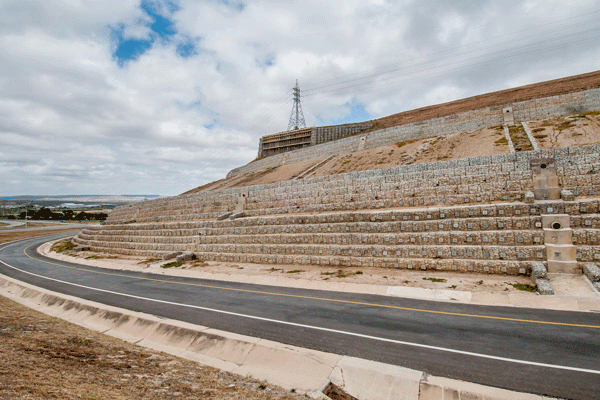
The South African National Roads Agency Limited (SANRAL) has saved Africa’s automotive manufacturing capital from power blackouts with an R80-million slope stabilisation engineering project in Nelson Mandela Bay.
The instability of the R75 on-ramp into Uitenhage was undermining the structural integrity of pylons carrying overhead electrical cables supplying large areas of Uitenhage with power. It has been a source of concern for authorities and industry since 2012.
The R75 was declared a national route in 2011 and was being investigated by SANRAL when the failure occurred.
Michelle Ah Shene, SANRAL’s communications officer in Port Elizabeth, said: “Sloughing or erosion problems [of the slope] began in the mid-1980s mainly due to the lack of maintenance. This, in turn, allowed moisture to seep into the slope. Previous methods of stabilisation were not effective as they only dealt with close to surface water or moisture contained within the slope.”
The project created 216 employment opportunities for 13 SMME’s over a 15 month contract period. SMME training in tendering and pricing; safety, health and environment aspects; concrete skills, and first aid was also provided.
Shene added that every time instability occurred, the failure zone encroached on these pylons, undermining the stability of the foundations.
Slope stabilisation
Extensive slope landmass movements were triggered by heavy rains during October 2012 in the Nelson Mandela Bay metro.
The rains created a 50m wide and 300m long slip along the R75 on-ramp, resulting in the movement of soil to the lower parts of the slope along the failure zone, further exasperating the risk of damage to the cables and a potential power blackout of Uitenhage.
The slope stabilisation programme included the excavation of 112 000 cubic metres of soil, the construction of 5 700 cubic metres of gabions in three continuous walls along the R75 on-ramp inclusive of grouted soil nails, construction drains at the top of the walls, and the installation drains for storm water run-off down the slope to the existing drainage system.
The project also included the construction of an earth catch water bank at the summit of the slope to prevent overland flow from the top running down the face.
Challenges experienced
SANRAL met and overcame two engineering challenges on the project.
The first encountered was the excavated face beneath the southern pylon. If it was completely excavated to its full height it would have been approximately 10m high.
“When it had been partly excavated some six to seven metres, it was prudent to install a system of temporary grouted soil nails plus geotextile and steel mesh to prevent the slope from collapsing,” said said Shene. “Had the temporary measures not been installed there would have been a danger of the collapse, endangering the lives of any person working below and could have, quite possibly, brought about the collapse of the electricity pylon standing at the top of the face.”
The second challenge occured during construction where the excavations opened up the face of the cut slope therefore exposing a geological fault in the material with considerable amounts of groundwater seepage from the fault.
Shene said: “The fault could lead to further sloughing of the existing cut face onto the R75 on-ramp. Additional stabilisation works in the form of gabions, soil nails, slope rehabilitation measures (top soiling and grassing) and trapezoidal drains were authorised.
“Geotechnical engineering is one of the fastest growing fields of engineering, albeit a relatively young one. Many pioneers within the field have carved a path for those that follow to help fill in the gaps in our knowledge of the fascinating world that lies beneath the earth’s surface.”
Shene further explained that most engineering projects deal with near surface challenges and solutions are effectively engineered, whereas slope stabilisation projects deal with more unknown challenges.

